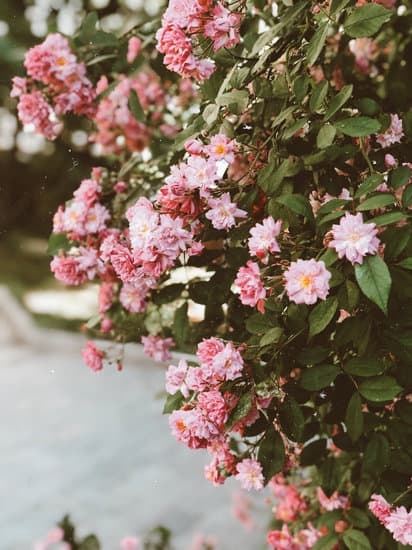Wall gardening has become a popular trend among DIY enthusiasts and gardening enthusiasts alike, offering a unique way to bring greenery into small spaces. In this article, we will delve into the world of wall gardening ideas DIY, exploring creative solutions for vertical plant displays and discussing the benefits of incorporating green walls into your home or outdoor space.
Creating a wall garden not only adds a touch of nature to your surroundings but also provides numerous advantages such as improved air quality, insulation, and noise reduction. Whether you have limited outdoor space or simply want to add a decorative element to your walls, wall gardening offers the perfect solution. From selecting the right wall for your project to choosing the best plants for vertical growth, there are endless possibilities to explore when it comes to wall gardening.
In the following sections, we will discuss how to choose the right wall for your DIY gardening project, creative ideas for vertical planters, essential tools and materials needed for successful wall gardening projects, and maintenance tips to ensure the longevity and health of your plants.
With our step-by-step guide and inspiring ideas for plant selection and arrangement, you’ll be well on your way to creating a stunning wall garden that will enhance both the aesthetic appeal and environmental impact of your space.
Choosing the Right Wall for Your DIY Gardening Project
When embarking on a DIY wall gardening project, one of the first considerations is choosing the right wall for your green endeavor. The ideal wall will provide ample sunlight, stability, and space for your plants to thrive. Before you start digging or installing any planters, take the time to assess different walls in your home or outdoor space.
Assessing Sunlight Exposure
First and foremost, consider the amount of sunlight the wall receives throughout the day. Most plants require at least 6-8 hours of sunlight to grow effectively. South-facing walls tend to receive the most sunlight in both the northern and southern hemispheres, making them ideal for sun-loving plants. However, if you have a wall that receives partial sunlight or shade, there are still plenty of plant options available to create a thriving wall garden.
Evaluating Structural Support
Another crucial factor to consider when selecting a wall for your DIY gardening project is its structural support. Ensure that the wall can hold the weight of planters, soil, and water without causing damage or instability. Avoid walls with cracks, crumbling mortar, or signs of weakness that could compromise the safety of your vertical garden. If you’re unsure about a wall’s strength, consult with a professional before proceeding with your project.
Optimizing Space
In addition to sunlight exposure and structural support, consider the available space on the chosen wall for your vertical garden. Determine how much surface area you have to work with and plan out the arrangement of planters accordingly.
Opt for vertical planters or hanging containers that maximize space utilization while adding visual interest to your living greenery display. By choosing a wall with optimal sunlight exposure, structural integrity, and space availability, you can set yourself up for a successful DIY wall gardening project filled with flourishing plants and natural beauty.
Vertical Planters
When it comes to wall gardening ideas DIY, vertical planters offer a versatile and visually appealing way to bring greenery into your living space. There are numerous creative ideas and designs that you can explore to create a stunning vertical garden on your wall. Whether you have limited floor space or simply want to add a unique touch to your home decor, vertical planters are the perfect solution.
One popular design for a vertical planter is the use of modular wall-mounted planters. These systems allow you to mix and match different plants, creating a customized look that suits your style. Another option is the use of pocket planters, which are small pouches attached to a panel that can be hung on the wall. This design is not only space-saving but also adds an interesting texture to your wall garden.
In addition to traditional pots and containers, consider using unconventional items like repurposed wooden crates or metal buckets as planters. Get creative with different shapes, sizes, and colors to make your vertical garden truly unique. Remember to choose plants that thrive in vertical environments, such as succulents, ferns, or herbs, to ensure the success of your wall gardening project.
| Vertical Planter Design | Description |
|---|---|
| Modular Wall-Mounted Planters | Allows mixing and matching of plants for a customized look. |
| Pocket Planters | Small pouches attached to a panel for space-saving design. |
Essential Tools and Materials for Successful Wall Gardening DIY
When embarking on a wall gardening DIY project, having the right tools and materials at your disposal is crucial for success. Here are some essential items you’ll need to ensure your vertical garden thrives:
- Vertical planters or containers: Selecting the appropriate containers for your wall garden is key. Whether you choose pocket planters, hanging baskets, or custom-built boxes, make sure they are durable and provide adequate drainage.
- Soil and compost: Use high-quality potting mix specifically formulated for container gardening. Ensure it is well-draining to prevent waterlogging, which can lead to root rot.
- Plants: Choose plants that thrive in vertical environments such as succulents, herbs, ferns, or trailing vines. Consider the amount of sunlight your wall receives to select suitable plants.
- Watering system: Depending on the size and location of your wall garden, consider installing a drip irrigation system or self-watering planters to ensure consistent moisture levels for your plants.
- Support systems: Installing trellises, stakes, or wire grids can provide support for climbing plants and help create structure in your vertical garden.
Having these tools and materials on hand will not only make the installation process smoother but also contribute to the long-term health and vitality of your wall garden. With proper preparation and planning, you can create a stunning vertical oasis in any indoor or outdoor space.
Step-by-Step Guide to Creating a Vertical Garden on Your Wall
Vertical gardening is a popular trend that allows individuals to maximize their space and bring nature into their homes or outdoor areas. When it comes to creating your own vertical garden on a wall, there are several key steps to ensure its success. One of the first things to consider is the location of your wall garden. Choose a spot that receives adequate sunlight based on the types of plants you plan to grow.
Once you have selected the wall for your DIY gardening project, it’s time to gather the necessary tools and materials. Some essential items include a stud finder, drill, screws, brackets, planters or pots, potting mix, and of course, your chosen plants. Make sure that the wall can support the weight of both the planters and soil when fully watered. It’s also important to consider proper drainage for your vertical garden to prevent water damage to your wall.
To start creating your vertical garden, begin by installing brackets or mounts on your wall where you want the planters to hang. Use a level to ensure they are straight before attaching them securely. Once the brackets are in place, hang your planters and fill them with potting mix. Carefully plant your desired greenery or flowers in each planter according to their individual needs. Regularly water and monitor your wall garden as needed to keep it thriving and looking beautiful.
| Tools | Materials |
|---|---|
| Stud finder | Planters/pots |
| Drill | Potting mix |
| Screws | Brackets |
Maintenance Tips for Wall Gardens to Ensure Longevity and Health of Plants
Vertical gardens are a beautiful and innovative way to bring greenery into small spaces, but they require proper maintenance to ensure the longevity and health of the plants. One key tip for maintaining a wall garden is to regularly check for pests or diseases that may be affecting your plants. Inspect the leaves, stems, and soil carefully to catch any issues early on and take appropriate action to prevent further damage.
Another important aspect of maintaining a wall garden is to water the plants correctly. Since vertical gardens have a unique design, water may not reach all the plants evenly. Be sure to water consistently and adjust based on the specific needs of each plant in your garden. Consider using a drip irrigation system or self-watering planters to make watering more efficient and effective.
In addition to pest control and watering, it’s crucial to regularly prune and trim your wall garden. Overgrown foliage can block sunlight from reaching other plants and lead to overcrowding, which can create a breeding ground for pests and diseases. By trimming back excess growth, you can promote airflow and encourage healthy plant development. Stay proactive in caring for your vertical garden to enjoy thriving and beautiful greenery year-round.
Inspiring Ideas for Plant Selection and Arrangement in Your Wall Garden
When it comes to creating a stunning wall garden, choosing the right plants and arranging them effectively are crucial steps in ensuring a successful DIY project. Whether you’re aiming for a vibrant, colorful display or a more minimalist, modern look, the selection and arrangement of plants will greatly influence the overall aesthetic of your vertical garden.
Plant Selection
Before starting your wall gardening project, consider the environmental conditions of your chosen wall, such as sunlight exposure and temperature. Select plants that are suitable for these conditions to ensure their health and vitality. Some popular options for wall gardens include succulents, herbs, ferns, mosses, and even small flowering plants. Mix and match different types of plants to create visual interest and variety in your vertical garden.
Arrangement Ideas
When it comes to arranging plants on your wall garden, the possibilities are endless. Consider creating patterns or designs with different colored foliage or textures to add visual appeal. You can also play with the heights of the plants by placing taller ones towards the back and shorter ones towards the front. Experiment with different shapes and sizes of planters to add depth and dimension to your vertical garden arrangement.
Theme-Based Gardens
Another fun idea is to create a theme-based wall garden by selecting plants that align with a specific color scheme or design concept. For example, you could create a herb garden with a variety of fragrant culinary herbs like basil, thyme, and rosemary. Or opt for a tropical-themed garden with lush green foliage plants like philodendrons and calatheas. The key is to let your creativity run wild and personalize your wall garden according to your style preferences.
Troubleshooting Common Issues in Wall Gardening Projects
Wall gardening projects can sometimes face common issues that may hinder the success and health of your plants. By being proactive and addressing these problems early on, you can ensure that your vertical garden thrives and flourishes. Here are some common issues you may encounter in your wall gardening project, along with tips on how to troubleshoot them:
1. Poor Drainage: One of the most common issues in wall gardening is poor drainage, which can lead to waterlogged roots and plant stress. To prevent this issue, make sure to use a well-draining soil mix specifically formulated for container gardening. Additionally, consider adding a layer of gravel or pebbles at the bottom of your planter to improve drainage.
2. Uneven Watering: In a vertical garden, it’s easy for water to run down quickly without evenly reaching all plants. To combat uneven watering, consider installing a drip irrigation system or using self-watering planters. You can also manually water your plants more frequently, paying close attention to those at the top and bottom of your wall garden.
3. Pests and Diseases: Just like traditional gardens, wall gardens are susceptible to pests and diseases that can harm your plants. Keep an eye out for any signs of infestations or fungal infections, such as yellowing leaves or wilting plants. Consider using organic pest control methods or natural remedies to keep your wall garden healthy.
By addressing these common issues in your wall gardening project proactively, you can enjoy a successful DIY vertical garden filled with lush greenery and beautiful blooms.
Showcasing Success Stories and Beautiful Examples of Wall Gardens for Inspiration
As you embark on your own wall gardening DIY project, it’s always inspiring to look at success stories and beautiful examples of wall gardens for motivation and ideas. From small urban spaces to expansive outdoor areas, there are endless possibilities for creating stunning vertical gardens that can transform any wall into a lush oasis.
One of the most impressive aspects of wall gardening is its versatility. Whether you prefer a minimalist design with sleek succulents and air plants or a vibrant display of colorful flowers and herbs, there is a style to suit every taste and space. By showcasing different success stories, you can see how others have creatively utilized vertical planters, hanging pots, trellises, and other innovative solutions to bring their walls to life.
Some gardeners have even combined wall gardening with other elements such as water features, seating areas, or outdoor artwork to create truly unique and eye-catching displays. By exploring these examples, you can gather valuable insights on plant selection, arrangement techniques, maintenance routines, and troubleshooting methods. Ultimately, these success stories serve as a testament to the boundless creativity and beauty that can be achieved through wall gardening ideas DIY.
Frequently Asked Questions
How Do I Make a Wall Garden?
Making a wall garden involves installing a vertical structure with shelves, pockets, or containers to hold plants. You can use various materials like pallets, shoe organizers, or hanging pots to create your wall garden.
How Do You Make a Vertical Vegetable Garden?
Creating a vertical vegetable garden starts with choosing a sunny location and building or buying a vertical structure like a trellis or tower. Next, select vegetables that grow well vertically, such as tomatoes, cucumbers, beans, peas, and peppers.
What Vegetables Grow Best in Vertical Gardens?
Certain vegetables thrive in vertical gardens due to their growth habits and support needs. Vegetables like tomatoes, cucumbers, pole beans, peas, squash, and peppers are well-suited for vertical gardening because they can climb or be trained to grow upward efficiently. These crops also tend to produce well in vertical spaces with proper care and maintenance.

Welcome to my gardening blog! I am passionate about plants and enjoy sharing my knowledge and experiences with others. In this blog, I will write about everything related to gardening, from tips on how to get started to updates on my own garden projects.





